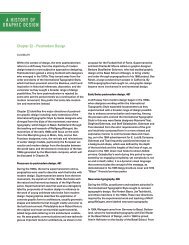Week 2 National Visions within a Global Dialogue - A History of ...
Week 2 National Visions within a Global Dialogue - A History of ...
Week 2 National Visions within a Global Dialogue - A History of ...
Create successful ePaper yourself
Turn your PDF publications into a flip-book with our unique Google optimized e-Paper software.
A HISTORY OFGRAPHIC DESIGNdirectness is seen in “Victory 1945,” awarded first prize in an international competition for a poster commemorating thethirtieth anniversary <strong>of</strong> the end <strong>of</strong> World War II. Playfulness and humor abound in his work (Figs. 23-28 through 23-30).Koichi Sato (b. 1944), page 491, His painting <strong>of</strong> a white tray—which he tilted so the blue-colored water filling it graduatedtoward one end—became an important inspiration for his evolution. Sato’s design balances opposites: traditional/futuristic, organic/mechanical, East/West, light/dark. He also writes haiku poetry; His graphic designs share the multiplelevels <strong>of</strong> meaning and expression <strong>of</strong> deep emotion found in this traditional form. Auras and glowing luminosity arefound in his work, bringing a metaphysical poetry to the printed page (Figs. 23-31 and 23-32).Wim Crouwel (b. 1928), Frisco Kramer, Benno Wissing (b. 1923), page 493, In 1963, graphic designer Wim Crouwel, productdesigner Frisco Kramer, and architectural designer Benno Wissing formed Total Design (TD) a large multidisciplinarydesign firm in Amsterdam.Pieter Brattinga (b. 1931), page 494, worked at his father’s printing firm, De Jong & Co., near Amsterdam, where helearned all aspects <strong>of</strong> printing. He established a small gallery at De Jong & Co. and presented exhibitions <strong>of</strong> advancedart and graphic design. He designed the posters for these exhibitions based on a grid <strong>of</strong> fifteen squares. The poster hedesigned for the1960 exhibition “De Man Achter due Vormgeving van de PTT” (“The Man Behind the Design for theDutch Postal Service”) uses translucency to communicate the concept <strong>of</strong> behind. Brattinga edited a journal, Kwadraatblad(Quadrate), which was published by De Jong & Co. and provided designers with a forum to experiment with theprint medium. He also designed posters and publications for the Krüller-Müller Museum in Otterlo (Fig. 23-37).Jean François van Royen (1878–1942), page 494, became general secretary <strong>of</strong> the Netherlands Postage and TelecommunicationsService (PTT) board in 1919 and emphasized aesthetic excellence in all areas, from telephone booths andbuildings to postage stamps. He died in a concentration camp in 1942.R. D. E. Oxenaar (b. 1929), page 495, In 1965, Oxenaar was selected to design Dutch paper currency and in 1976, he wasappointed the aesthetic advisor to the Netherlands Postage and Telecommunications Service (PTT). Under his leadership,PTT achieved visual innovation (Fig. 23-39).Anthon Beeke (b. 1940), page 495, participated in Fluxus, which helped him seek unconventional solutions to visualcommunications assignments; he emerged as a provocateur pushing for maximum freedom <strong>of</strong> expression andthought. His posters <strong>of</strong>ten use photographic depictions <strong>of</strong> the human figure that are embellished with objects, fragmented,distorted, or altered to create jolting ambiguities, unexpected perceptual experiences, and shocking messages(Figs. 23-41 through 23-43).Jan van Toorn (b. 1922), page 495, explores means <strong>of</strong> organizing information to challenge the viewer to participate inthe perception process and examine the meaning and motives <strong>of</strong> visual messages. His memorable designs are <strong>of</strong>tenassembled <strong>of</strong> intentionally provocative images and idiosyncratic font choices in unfinished montages rather than seamlesscompositions (Fig. 23-40).Ghislain (Gielijn) Dapnis Escher (b. 1945), page 497, Through their simplicity and flat surfaces <strong>of</strong> color, his posters standout from the urban surroundings where they hang, and through their quiet dignity they attract attention on crowdedstreets (Figs. 23-44 through 23-46).Gert Dumbar (b. 1940), page 497, founded Studio Dumbar in 1977. Originally located in The Hague and then in Rotterdam,this studio has a comprehensive range, designing everything from experimental graphics for cultural clients tocorporate identity programs and literature. He developed a technique he called staged photography, consisting <strong>of</strong> stilllifes and environments incorporating found material and papier-mâché figures and objects sculpted or assembled forthe project. Illustration, photography, typography, and sculpture were integrated into a lively visual syntax (Figs. 23-47through 23-50).Irma Boom (b. 1969), page 501, specializes in making books. She sees them as sculptural objects, which can provide anadditional aspect to the text (Fig. 23-56).Helmut Brade (b. 1937), page 501, a German designer who remains faithful to the more traditional methods <strong>of</strong> graphicdesign. He works as a graphic and stage designer, his colorful and highly illustrative posters displaying wry humor ef-
















